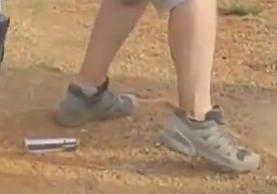- cross-posted to:
- [email protected]
Sara Nanni, the German Green Party defence spokesman, said one clear lesson is that the country simply needs to have more systems available. “We can no longer think in such small quantities. We have to assume that vehicles have a long downtime after they’re damaged and simply need to be serviced.”
Jesus Christ. I knew the German Green party was flawed because of the anti-nuclear stuff but to also find out they’re MIC shills. Fucked.
They’re the most bellicose and anti-russian party here in germany. They do not even pretend not to be a US-fifth-column. They got into the government with the promise to be strict about not letting germana rms be exportet into warzones. Ukraine made them drop that instantly, they’re also rabid zionazis. Baerbock (the worst foreign minister we ever had, and we had nazis on that job) immediately claimed to have seen the made up video of the 40 beheaded israeli babies.
For her “good work” she’s getting a prestigious diplomatic position at the UN, costing a experienced and respected diplomat their post.
It’s wild to me because the Green Party in America is (obviously) quite different, but they share the same name.
I thought the Leopard was a good tank platform. What’s wrong with them?
Here’s the full text of the article (since it’s paywalled):
–
www.telegraph.co.uk
German Leopard 2 tanks flop on battlefield in Ukraine
Aaron Burnett
5 - 6 minutesVulnerability to drones sees soldiers using prized weapons as glorified artillery
Germany’s prized Leopard 2 tanks are failing on the battlefield in Ukraine, according to an assessment by its defence ministry.
In a classified transcript of a meeting between a German defence attaché stationed in Kyiv and about 200 Bundeswehr soldiers, the diplomat revealed the difficulties Ukrainians are facing in operating the heavy weaponry.
Eighteen of the Bundeswehr’s mainstay Leopard 2 tanks made their way to Ukraine in 2023 after months of foot-dragging by Chancellor Olaf Scholz and a full-on national public debate about whether Berlin should send heavy weapons to Ukraine.
Mr Scholz finally agreed to do so after the Biden administration agreed to send Abrams tanks and public sentiment in Germany began to shift in Ukraine’s favour.
But for all the fanfare, Ukrainian soldiers are finding the Leopard 2 has limited use, says the transcript, which was obtained by three German media outlets.
Some of the problems have to do with the way warfare itself is changing.
Leopard 2s are vulnerable to drone strikes, like tanks in general, the transcript reads. However, the Leopard 2’s complicated design makes it difficult to repair on the battlefield, meaning that damaged Leopards must be sent to specialised repair crews in west Ukraine or even go all the way to Poland to be fixed and maintained.
In many cases, the Leopard 2’s problems have forced Ukrainian battalions into using them mostly as glorified artillery.
“The main problem with Leopard 2s given to Ukraine is that there’s too few of them. If one or two have to be repaired, that’s a big part of what Ukraine has that’s suddenly out of commission for a while,” said Sergej Sumlenny, managing director of the Berlin-based European Resilience Initiative Center.
He has made almost monthly trips to the frontline since 2022. He added: “Leopard 2s were also not designed for the Ukrainian battlefield. They function well when they have good air support, but Ukraine is short on this.” A soldier is seen on one of the tanks during training at the Swietoszow military base in Poland A soldier is seen on one of the tanks during training at the Swietoszow military base in Poland Credit: WOJTEK RADWANSKI
Mr Sumlenny said German post-war thinking plays a role too. “They were designed by a generation of German manufacturers that hadn’t seen war, and so tended to overcomplicate the system.
“Older systems, designed in the 1960s by those who actually saw war, are far more useful on the battlefield but have weaker armour.”
Defence experts in Germany say Ukraine’s battlefield experience has clear lessons for the country’s own procurement, particularly if Russia chooses to test Nato.
Sara Nanni, the German Green Party defence spokesman, said one clear lesson is that the country simply needs to have more systems available. “We can no longer think in such small quantities. We have to assume that vehicles have a long downtime after they’re damaged and simply need to be serviced.”
Germany is the second-largest supplier of military equipment to Ukraine after the US, with the leaked transcript also identifying other issues with German-supplied systems, noting that even well-functioning equipment – such as air defence assets – suffered from inadequate ammunition stocks.
In December, Jake Sullivan, the former US national security adviser, admitted that US-supplied Abrams tanks were “not the most useful piece of equipment” for Ukraine.
Ukrainian media reported that, like the Leopard, the logistics of maintaining the tanks had become “too much of a burden”.
Mark Hertling, a retired US army general, told CNN in June last year that Abrams tanks were a technological marvel, but they had immense maintenance demands.
“These are incredible tanks, but they require a sophisticated supply chain to keep them running. Fuel consumption is enormous, and they demand specialised maintenance that could strain Ukraine’s existing capabilities,” he said.
Of the around 80 Abrams tanks given to Ukraine by the US and Australia, roughly 20 are reported to have been destroyed, disabled or captured.
Kyiv has reported similar issues with the British-donated Challenger 2 tank, with a Ukrainian crewman telling The Sun last year that they often broke down and could not be repaired easily.
“It takes a long time to get spares. The logistics are very complex, at this end and your end,” the servicemen said.
In short: Good, if you have air superiority,have your maintenance facilities close by.
Things one does not tend to have in a near peer conflict.
So it’s combo of drones being a huge threat to armoured vehicles in general (no surprise there, it was clear pretty early on that drones are a game changer akin to the machine gun in WW1) and the inevitable logistical issues that comes from running an army based on a hodge-podge of obsolete vehicles from a dozen different sources.





